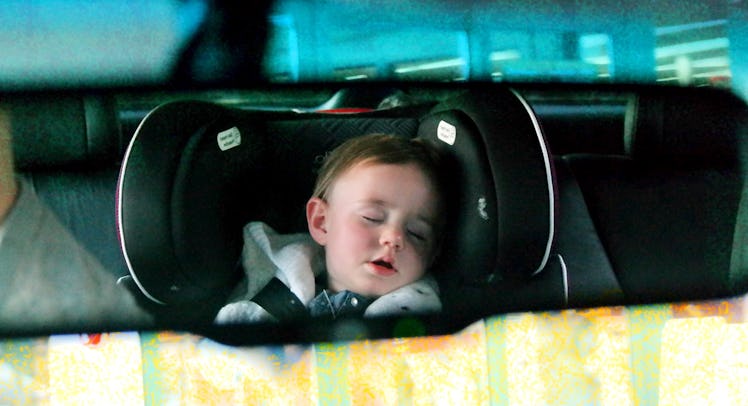Why Driving Puts Your Baby to Sleep
A few reasons car rides are (usually) so damn quiet.

New parents drive an average of 1,322 miles per year to put their kids to sleep, according to a 2012 UK study. Dads averaged up to 1,827 miles in the study, and half of all the parents surveyed admitted to driving their kids around to get them to sleep at least once a week. Our kids drive us crazy and we, in turn, drive them to sleep.
And it works—the question is why. Scientists cars may lull babies asleep because the soft, rocking motion of the car, along with the purr of the engine, reminds our little ones of tranquil life in utero. “Babies in the womb are constantly, gently, rocking and a cars offer that kind of very low-level of movement—almost just swaying in a sense,” developmental psychologist Tracy Cassels told Fatherly. As for the engine, “it’s white noise that babies also are used to,” Cassels says. “This muffled kind of sound in the womb.”
Although the trick may work in the long-term — some adults feel sleepy whenever an engine starts to thrum — conjuring the womb as a way to induce sleep is a trick that probably won’t work after one year. Studies have shown that similar tricks (rocking, carrying, pacing) become less effective after about three months of life.
Still, the car is no surefire sleep guarantee. You’ll want to make sure to check the other possible causes for crying first — a wet or hungry baby isn’t going to calm down just because you remind him or her of life in utero. Even then, babies and small children may find car rides distressing rather than soothing, because the car inherently separates them from their caregivers. “In some cases, being separate from a caregiver is actually highly distressing for some kids,” Cassels says. “And that kind of enclosure is distressing. They actually need the physiological regulation from a caregiver and that touch actually regulates the temperature, heart rate.”
Children may also find themselves unable to snooze because of your driving technique. Suffice to say the womb didn’t involve very many stops, starts, and crude jerking motions. If you drive in the city (or just drive poorly in the suburbs) you may find that your child keeps screaming even as you clock mile after mile. At that point, it may be time to surrender — studies have shown that crying babies can distract drivers and cause accidents.
Cassels offers a handful of solutions for these problems. “There are mirrors now that you can put in on the back seat, so if the baby’s rear-facing, the mirror is there on the headrest of the seat, and they’re looking at it,” she says. “It not only allows you to see the baby, but often times they can then see you.” (Peace of mind for both dad and baby — although it’s unclear whether such mirrors are safe in a crash). If both mom and dad are in the car, Cassels says, a safer and more reassuring option is to have one parent sit in the back with the baby.
“That can help them start to adapt to the car and feel safer in it,” she says. Perhaps they’ll even nod off.
This article was originally published on